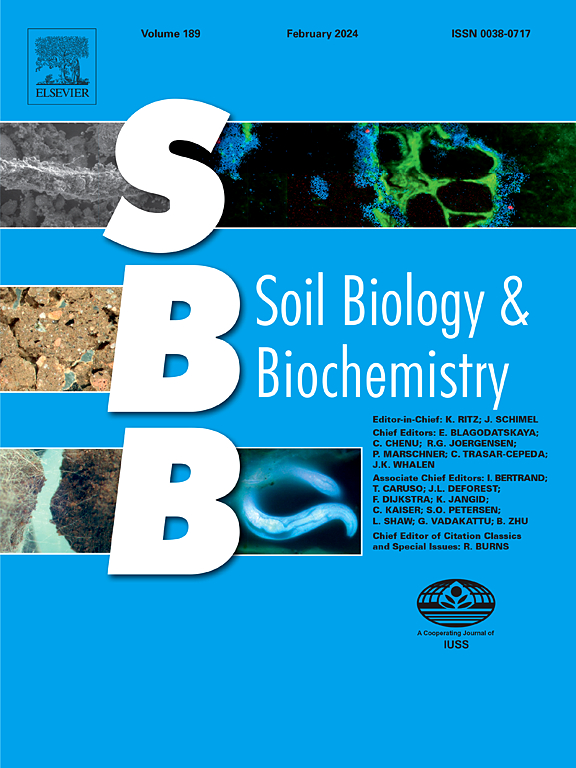铁-有机碳关联的减少改变了永久冻土初始解冻后的净温室气体释放
IF 9.8
1区 农林科学
Q1 SOIL SCIENCE
引用次数: 0
摘要
在融化的永久冻土中,有机碳(OC)和铁(Fe(III))(氧合)氧化物矿物之间的联系可能稳定最近融化的土层中的OC,从而限制微生物介导的温室气体(ghg)的释放,如二氧化碳(CO2)和甲烷(CH4)。相反,解冻期间缺氧条件的发展可能导致这些Fe(III)-OC关联的微生物还原性溶解,导致相关OC的动员,对温室气体释放的影响未知。在这项研究中,我们研究了在瑞典阿比斯科(Abisko, Sweden)的Stordalen沼泽(Abisko, Sweden),在先前的含氧永久冻土(“palsa”)崩塌和季节性缺氧土壤(“bog”)淹没期间,Fe(III)-OC结合(以Fe(III)-OC共沉淀的形式)在土壤温室气体释放中的作用。我们在这两种土壤中添加了57fe标记的Fe(III)-OC共沉淀物,进行了缺氧微观环境实验。42 d后共沉淀完全还原,1 d内共沉淀快速还原溶解率分别为22±7%和20±7%。温室气体的排放量因土壤类型而异:在palsa土壤中,与未添加铁(III)-OC共沉淀物的对照相比,添加铁(III)-OC共沉淀物后,累积二氧化碳排放量增加了43±16%,这是由于微生物铁(III)的减少加上OC的氧化,以及铁结合OC的释放可能导致额外的OC输入。同时,我们观察到发酵和复杂oc降解微生物的活性增加。值得注意的是,在沼泽土壤中,CH4的排放暂时受到抑制,这可能是由于微生物Fe(III)减少了添加的共沉淀物,抑制了甲烷生成,这表明mcrA基因拷贝数减少。综上所述,我们的研究结果表明,在永久冻土解冻过程中建立缺氧条件后,Fe(III)-OC关联并没有为OC提供保护,导致温室气体排放受到土壤和微生物群落先前氧化还原状态的控制。本文章由计算机程序翻译,如有差异,请以英文原文为准。


Reduction of iron-organic carbon associations shifts net greenhouse gas release after initial permafrost thaw
In thawing permafrost soils, associations between organic carbon (OC) and ferric iron (Fe(III)) (oxyhydr)oxide minerals may stabilize OC in recently thawed soil layers, thus limiting the microbially mediated release of greenhouse gases (GHGs) such as carbon dioxide (CO2) and methane (CH4). Conversely, the development of anoxic conditions during thaw could lead to the microbial reductive dissolution of these Fe(III)-OC associations, resulting in a mobilization of the associated OC with unknown consequences for GHG release. In this study, we investigated the role of Fe(III)-OC associations (in the form of Fe(III)-OC coprecipitates) in soil GHG release during the collapse of previously oxic permafrost soils (“palsa”) and the inundation of seasonally anoxic soils (“bog”) at Stordalen Mire (Abisko, Sweden). We performed anoxic microcosm experiments using these two soils with the addition of 57Fe-labeled Fe(III)-OC coprecipitates. The coprecipitates were reduced entirely after 42 days, with rapid reductive dissolution of 22 ± 7% and 20 ± 7% of coprecipitates within 1 day in palsa and bog soils, respectively. Emissions of GHG varied depending on soil type: in case of the palsa soil, cumulative CO2 emissions increased by 43 ± 16% after addition of the Fe(III)-OC coprecipitates compared to a non-amended control, due to microbial Fe(III) reduction coupled to OC oxidation and likely additional OC input due to the release of Fe-bound OC. Concurrently, we observed an increase in activity of fermenting and complex OC-degrading microorganisms. Within the bog soil, it was notable that CH4 emissions were temporarily suppressed, likely due to inhibition of methanogenesis by microbial Fe(III) reduction of the added coprecipitates, indicated by a decrease in mcrA gene copies. In conclusion, our findings demonstrate that Fe(III)-OC associations do not provide protection for OC after establishment of anoxic conditions during permafrost thaw, with resulting GHG emissions controlled by previous redox status of the soils and the microbial community.
求助全文
通过发布文献求助,成功后即可免费获取论文全文。
去求助
来源期刊

Soil Biology & Biochemistry
农林科学-土壤科学
CiteScore
16.90
自引率
9.30%
发文量
312
审稿时长
49 days
期刊介绍:
Soil Biology & Biochemistry publishes original research articles of international significance focusing on biological processes in soil and their applications to soil and environmental quality. Major topics include the ecology and biochemical processes of soil organisms, their effects on the environment, and interactions with plants. The journal also welcomes state-of-the-art reviews and discussions on contemporary research in soil biology and biochemistry.
 求助内容:
求助内容: 应助结果提醒方式:
应助结果提醒方式:


